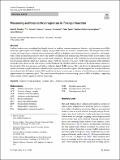Measuring auditory cortical responses in Tursiops truncatus
Abstract
Auditory neuroscience in dolphins has largely focused on auditory brainstem responses; however, such measures reveal little about the cognitive processes dolphins employ during echolocation and acoustic communication. The few previous studies of mid- and long-latency auditory-evoked potentials (AEPs) in dolphins report different latencies, polarities, and magnitudes. These inconsistencies may be due to any number of differences in methodology, but these studies do not make it clear which methodological differences may account for the disparities. The present study evaluates how electrode placement and pre-processing methods affect mid- and long-latency AEPs in (Tursiops truncatus). AEPs were measured when reference electrodes were placed on the skin surface over the forehead, the external auditory meatus, or the dorsal surface anterior to the dorsal fin. Data were pre-processed with or without a digital 50-Hz low-pass filter, and the use of independent component analysis to isolate signal components related to neural processes from other signals. Results suggest that a meatus reference electrode provides the highest quality AEP signals for analyses in sensor space, whereas a dorsal reference yielded nominal improvements in component space. These results provide guidance for measuring cortical AEPs in dolphins, supporting future studies of their cognitive auditory processing.
Citation
Schalles , M D , Houser , D S , Finneran , J J , Tyack , P , Shinn-Cunningham , B & Mulsow , J 2021 , ' Measuring auditory cortical responses in Tursiops truncatus ' , Journal of Comparative Physiology A , vol. First Online . https://doi.org/10.1007/s00359-021-01502-5
Publication
Journal of Comparative Physiology A
Status
Peer reviewed
ISSN
1432-1351Type
Journal article
Description
Financial support was provided by the Office of Naval Research Code 32 (Mine Countermeasures, Acoustics Phenomenology and Modeling Group), and funded by ONR grants N00014-18-1-2062, N00014-19-1-1223, N00014-18-1-2069, and N00014-20-1-2709.Collections
Items in the St Andrews Research Repository are protected by copyright, with all rights reserved, unless otherwise indicated.

